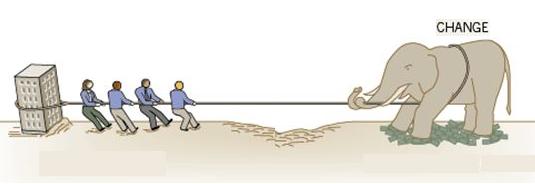Change comes from anywhere, and is the only constant. Propelled by the driving force of technology and globalization, the economic landscape continuously transform in a way that has come to undermine the relevance of received wisdom on how a firm should be managed and what underlies its success. In this new millennium, it is more challenging for an organization to sustain its competency or even survive in the diversity market. When an organization is threatened by environmental changes such as crisis or competition, it results in the increasing needs for communication as technology develops rapidly and higher customer demands will be foreseen. Organizational change is not an option; it constitutes a fundamental necessity for success within the new competitive landscape. An organization need to evaluate its performance and review its business strategies, corporate structure, operational process and HR policies to identify the areas that need transformation. To maintain its competitiveContinue reading
Change Management
Levels of Organizational Change Programs
The various levels of organizational change programs may be classified into individual level changes, group level changes and organisational level changes. Individual Level Change Programs Individual level changes may take place due to changes in job assignment, transfer of an employee to a different location or the changes in the maturity level of a person which occurs over a passage of time. The general opinion is that change at the individual level will not have significant implications for the organisation. But this is not correct because individual level changes will have impact on the group which in turn will influence the whole organisation. Therefore, a manager should never treat the employees in isolation but he must understand that the individual level change will have repercussions beyond the individual. Group Level Change Programs Management must consider group factors while implementing any change, because most of the organisational changes have their majorContinue reading
Minimizing Resistance to Change through Discussions
When as many as possible of those people involved in a change understand as much as possible about it and its consequences, resistance is likely to be reduced. It is management’s job to develop this understanding. Resistance will be prevented to the degree that the change agent help the change affected people to develop their own understanding of the need for change, and an explicit awareness of how they feel about it and what can be done about their feelings. Such an understanding will occur only when the information provided is sufficient, factual and accurate. Management can transmit information about a proposed change and its probable consequences to those affected or concerned in a variety of ways. Fundamentally, there are only three practical media for communication; written material, audio-visual and oral. No single means, however, should be relied on exclusively. The more complex the change, the greater will be theContinue reading
Overcoming Resistance to Change
In the previous post, we deal with the various sources of resistance to change. In this post we discusses strategies and tactics to overcome resistance to organizational change. Kotter and Schelsinger (1979) has identified six general strategies for overcoming resistance to change. Education and Communication : Resistance can be reduced through communicating with employees to help them see the logic of a change. This tactic basically assumes that the source of resistance lies in misinformation or poor communication. If employees receive the full facts and get any misunderstanding cleared up, resistance will subside. Communication can be achieved through one-to-one discussions, memos, group presentations, or reports. Does it work? It does, provided the source of resistance is inadequate communication and that management-employee relations are characterized by mutual trust and credibility. If these conditions don’t exist, the change is unlikely to succeed. Participation and Involvement : It is difficult for individualsContinue reading
Sources of Resistance to Change
The goal of planned organizational change is to find new or improved ways of using resources and capabilities in order to increase an organization’s ability to create value and improve returns to its stakeholders. An organization in decline may need to restructure its resources to improve its fit with the environment. At the same time even a thriving organization may need to change the way it uses its resources so that it can develop new products or find new markets for its existing products. In the last decade, over half of all Fortune 500 companies have undergone major organizational changes to allow them to increase their ability to create value. One of the most well-documented findings from studies have revealed that organizations and their members often resist change. In a sense, this is positive. It provides a degree of stability and predictability to behavior. If there weren’t some resistance, organizationalContinue reading
Unplanned Organizational Change
Not all the forces for organization change are the results of strategic planning. Indeed organizations often are responsive to unplanned organizational changes — especially those derived from the factors internal to the organization. Two such forces of unplanned organizational change are the changes in the demographic composition of the workforce and performance gaps. Changing Employee Demographics : It is easy to see, even within our own lifetimes, how the composition of the workforce has changed. The percentage of women in the workforce is greater than ever before. More and more women with professional qualifications are joining the organization at the junior and the middle management levels. In addition to these, the workforce is getting older. Many of the old retired employees from government and public sector are joining the private sector, thereby changing the employee demographics. With the opening up of the economy and globalization, the workforce is also continuallyContinue reading


